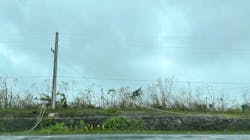BPA Volunteers Aid Typhoon Mawar Restoration Efforts in Guam
Three employees from the Bonneville Power Administration undertook 14-day missions as volunteers in Emergency Support Function #12 to assist in the restoration of power after Guam was hit by tropical storm winds reaching speeds of 140 mph.
In anticipation of Typhoon Mawar’s approach and the potential direct impact on Guam, three BPA employees were dispatched to support the Federal Emergency Management Agency’s efforts to preposition resources for power restoration. The super typhoon was projected to be the strongest storm to hit Guam in over 60 years, affecting approximately 150,000 residents. When it made landfall, Mawar plunged the island into darkness and subjected it to sustained winds of 140 mph.
Michael Hulse, a supervisory electrical engineer in Asset Reliability, Performance and Maintenance, along with Kelly Miller, a supervisory civil engineer in the Transmission Structural and Civil Engineering group, joined Hester in responding to FEMA’s request for assistance. Their role involved providing on-site assessments before and after the storm, which Hulse referred to as “ground truthing.”
As members of Emergency Support Function #12, they worked alongside the Department of Energy and FEMA to comprehend the extent of the impact and the condition of the electrical system following landfall. They acted as intermediaries between state and local governments, fuel suppliers, and all other parties affected on the island.
As part of the Catastrophic Incident Response Team under ESF #12, the BPA volunteers were responsible for assessing damages and assisting in restoration planning. Hester and Miller were on the front lines, conducting meetings with local utility companies and fuel suppliers like Mobil to evaluate their readiness and resources available to repair the power grid.
Hulse, in his role as a CIRT communicator, operated from the field office and coordinated activities with the DOE. This was crucial during the storm to expedite the restoration of A.B. Won Pat International Airport, a critical hub for receiving aid and equipment to support the island’s recovery efforts.
During the storm, the three volunteers stayed in their hotel rooms with satellite phones, providing hourly updates on the situation and ensuring their safety by contacting the DOE. Once the winds subsided below tropical storm levels, they ventured out of their shelters and commenced their work.
Despite the storm’s severity, Miller noted that Guam’s power system demonstrated resilience due to previous enhancements made after Super Typhoon Pongsona in 2002.
Hester projected that the island would achieve 95% power restoration within 30 days, an impressive feat following a Category 4 storm. Comparatively, it took six months for Saipan to reach the same level of restoration after Typhoon Yutu.
The initial group of three volunteers remained deployed for a total of 14 days, after which they were relieved by a second wave of BPA volunteers consisting of Bret Aguirre, a supervisory electronics engineer in Transmission Engineering and Technical Services, David Kirsch, an electrical engineer in the Operations Control group, and Jared Perez, a supervisory civil engineer in Construction Management. A third wave of volunteers included Todd Anderson, a work planner scheduler in Construction and Maintenance.
About the Author
T&D World Staff
Content Team
Nikki Chandler
Group Editorial Director, Energy
[email protected]
Jeff Postelwait
Managing Editor
[email protected]
Christina Marsh
Senior Editor
[email protected]
Ryan Baker
Associate Editor
[email protected]
Amy Fischbach
Electric Utility Operations
[email protected]
Rich Maxwell
Community Editor
[email protected]
Gene Wolf
Technical Editor
[email protected]
